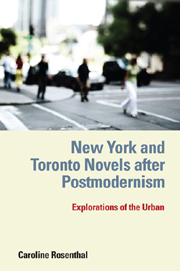Book contents
- Frontmatter
- Contents
- Preface and Acknowledgments
- Introduction
- 1 Imagining National Space: Symbolic Landscapes and National Canons
- 2 Articulating Urban Space: Spatial Politics and Difference
- 3 “The Inadequacy of Symbolic Surfaces”: Urban Space, Art, and Corporeality in Siri Hustvedt's What I Loved
- 4 Rewriting the Melting Pot: Paule Marshall's Brownstone City in The Fisher King
- 5 Specular Images: Sub/Urban Spaces and “Echoes of Art” in Carol Shields's Unless
- 6 “The End of Traceable Beginnings”: Poetics of Urban Longing and Belonging in Dionne Brand's What We All Long For
- 7 Synthesis
- Bibliography
- Index
1 - Imagining National Space: Symbolic Landscapes and National Canons
Published online by Cambridge University Press: 12 September 2012
- Frontmatter
- Contents
- Preface and Acknowledgments
- Introduction
- 1 Imagining National Space: Symbolic Landscapes and National Canons
- 2 Articulating Urban Space: Spatial Politics and Difference
- 3 “The Inadequacy of Symbolic Surfaces”: Urban Space, Art, and Corporeality in Siri Hustvedt's What I Loved
- 4 Rewriting the Melting Pot: Paule Marshall's Brownstone City in The Fisher King
- 5 Specular Images: Sub/Urban Spaces and “Echoes of Art” in Carol Shields's Unless
- 6 “The End of Traceable Beginnings”: Poetics of Urban Longing and Belonging in Dionne Brand's What We All Long For
- 7 Synthesis
- Bibliography
- Index
Summary
Every mature nation has its symbolic landscapes. They are part of the iconography of nationhood, part of the shared ideas and memories and feelings which bind a people together.
— D. W. Meinig, “Symbolic Landscapes”A symbolic landscape is commonly supposed to condense and clarify a meaning that is elsewhere found in a diffuse and ambiguous form…. This makes it possible to form an intuitive comprehension of something that is otherwise too large, complex, and abstract for immediate apprehension.>
— Jonathan M. Smith, “The Place of Nature”The Spatial Narratives of Nations
SPACES ARE NOT SIGNIFICANT in and by themselves but are produced as intelligible entities by how we organize them, by the social practices and symbolic ways in which we set them off from other spaces. The city, for instance, only gains significance as a space with distinct characteristics when separated from rural or unsettled, “wild” space. Nations define themselves spatially against other nations not only through geographic borders, history, and politics, but also through the specific ways they have found to classify and represent spaces. Images and imaginations of places become part of distinct “national iconographies” that differ in how they read spaces through national discourses. Cities are neither isolated nor self-evident places but are embedded in the history of space and of spatiality in the respective national culture. In contrast to a physical view of space, the notion of spatiality emphasizes that space is not primordial or naturally given but is instead produced in social practices — to the same extent that the social is spatially organized.
- Type
- Chapter
- Information
- New York and Toronto Novels after PostmodernismExplorations of the Urban, pp. 11 - 48Publisher: Boydell & BrewerPrint publication year: 2011

